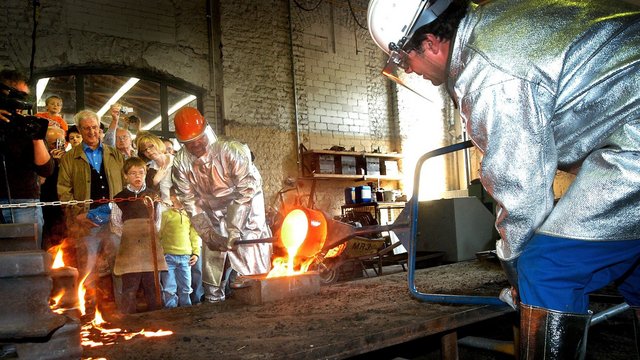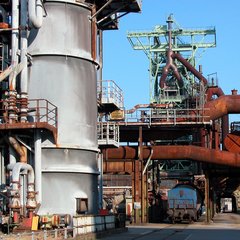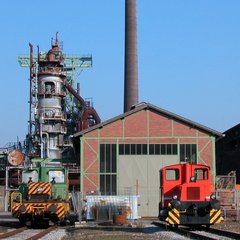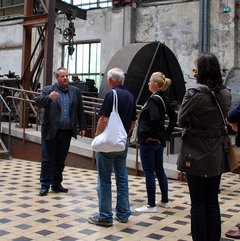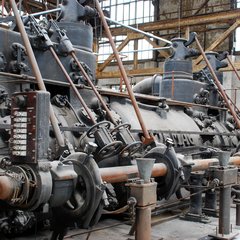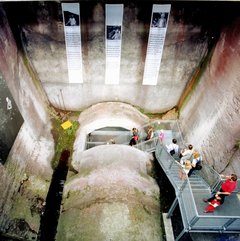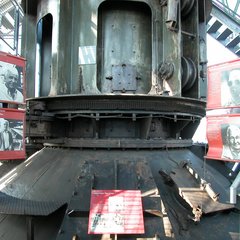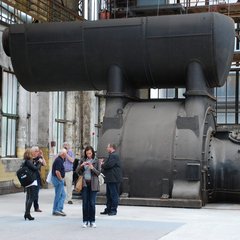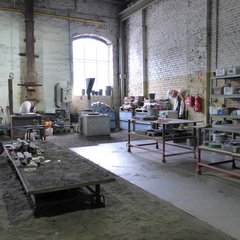The Henrichshütte Ironworks Hattingen
The story of iron, steel and the people who produced it: That's what the Henrichshütte in Hattingen, one of eight sites of the LWL Museums of Industrial Culture, is centred around. Visitors are invited to discover the varied aspects of the industrial monument by following several theme routes. The path of iron starts at the ore and coal bunkers, takes the elevator straight up the oldest blast furnace of the Ruhr district and continues to the casting hall where workers once defied the showers of sparks in the launder. The blast house, as part of the path of steel, displays a large gas engine weighing 500 metric tons. Together with ten other giants of its kind it provided most of the energy supply well into the sixties. An enormous steel converter stands for the processing of iron into steel, while steam hammers and a section rolling mill illustrate further steps of steel production. The green path traces the very specific flora and fauna of the industrial wasteland, and the path of the rat offers exciting experiences for children. But there is even more to discover: a hands-on foundry where visitors can try their skills as casters and moulders, a collection of ores including a symbolic trip to the earth's centre, and of course guided tours exploring the site at night featuring torches.
The Henrichshütte Ironworks Hattingen
Werksstraße 25
45527 Hattingen
Ennepe-Ruhr-Kreis
NRW
Germany
+49 (0) 2324 - 92470
Homepage
History
This site is the incarnation of all features that shape the image of the Ruhr district: pure heavy industry, tough workers, a plant as the centre of live through generations, labour conflicts, decline and new beginning. Occasionally up to 10.000 people were employed here. They extracted ores and coal, produced coke, iron and steel and processed the metal by casting, rolling and forging it. In a variety of films, displays and interviews they explain how all this was done – in a manner so lively as if they just stopped working.
Founded in 1854 the Henrichshütte is one of the oldest ironworks in the Ruhr district. The first owner was Count Henrich zu Stollberg-Wernigerode stepping into the brand-new technology of coke ovens since the charcoal fuelled blast furnaces he operated in the Harz mountains had become unprofitable. In the coming decades the Henrichshütte repeatedly changed hands and witnessed extensive modernisation. From 25 metric tons processed by the first blast furnace on a daily basis the output grew to 800 metric tons per day in 1940 as to the still existing "blast furnace 3". After the devastation of the Second World War it took quite a time until production was resumed, and it was only in 1963 that the plant restarted operation with two blast furnaces. Their daily output – 2.400 metric tons each – was three times as high as during the war.
For the workers the Henrichshütte was more than a place to earn their living. It was the focus of everyday life. That's why closing down operations in 1987 provoked bitter protests throughout the region. But the shutdown was irreversible. In 1989 the local authority (the Landschaftsverband Westfalen-Lippe) took over the disused premises to create the the Museum covering a size of 50.000 square metres in total. Since its opening in 2000 it has devoted itself to hands-on industralisation.
| Recommended duration of visit: | 2 Hours |
|---|---|
| Duration of a guided tour: | 90 Minutes |
| Admission: | Charge |
| Access for persons with disabilities: | For details see website |
| Infrastructure for children: | |
| Catering: | |
| Visitor centre on site: | yes |
| Gift and book shop on site: | yes |
Tuesday - Sunday 10am-6pm
- Guided tours optional
- Tours in other languages
- Guided tours for children


